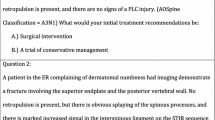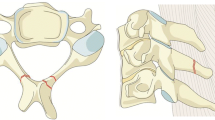Abstract
Purpose
The AO Spine Classification Group was established to propose a revised AO spine injury classification system. This paper provides details on the rationale, methodology, and results of the initial stage of the revision process for injuries of the thoracic and lumbar (TL) spine.
Methods
In a structured, iterative process involving five experienced spine trauma surgeons from various parts of the world, consecutive cases with TL injuries were classified independently by members of the classification group, and analyzed for classification reliability using the Kappa coefficient (κ) and for accuracy using latent class analysis. The reasons for disagreements were examined systematically during review meetings. In four successive sessions, the system was revised until consensus and sufficient reproducibility were achieved.
Results
The TL spine injury system is based on three main injury categories adapted from the original Magerl AO concept: A (compression), B (tension band), and C (displacement) type injuries. Type-A injuries include four subtypes (wedge-impaction/split-pincer/incomplete burst/complete burst); B-type injuries are divided between purely osseous and osseo-ligamentous disruptions; and C-type injuries are further categorized into three subtypes (hyperextension/translation/separation). There is no subgroup division. The reliability of injury types (A, B, C) was good (κ = 0.77). The surgeons’ pairwise Kappa ranged from 0.69 to 0.90. Kappa coefficients κ for reliability of injury subtypes ranged from 0.26 to 0.78.
Conclusions
The proposed TL spine injury system is based on clinically relevant parameters. Final evaluation data showed reasonable reliability and accuracy. Further validation of the proposed revised AO Classification requires follow-up evaluation sessions and documentation by more surgeons from different countries and backgrounds and is subject to modification based on clinical parameters during subsequent phases.













Similar content being viewed by others
References
Holdsworth F (1970) Fractures, dislocations, and fracture-dislocations of the spine. J Bone Jt Surg (Am) 52:1534–1551
Whitesides TE Jr (1977) Traumatic kyphosis of the thoracolumbar spine. Clin Orthop Relat Res 128:78–92
Denis F (1983) The three column spine and its significance in the classification of acute thoracolumbar spinal injuries. Spine 8:817–831
Wood KB, Khanna G, Vaccaro AR, Arnold PM, Harris MB, Mehbod AA (2005) Assessment of two thoracolumbar fracture classification systems as used by multiple surgeons. J Bone Jt Surg (Am) 87:1423–1429
Oner FC, Ramos LM, Simmermacher RK, Kingma PT, Diekerhof CH, Dhert WJ, Verbout AJ (2002) Classification of thoracic and lumbar spine fractures: problems of reproducibility. A study of 53 patients using CT and MRI. Eur Spine J 11:235–245
Aebi M (2010) Classification of thoracolumbar fractures and dislocations. Eur Spine J 19:S2–S7
Audigé L (2009) Development and validation of a new generation for spine injury classification. In: Chapman JR, Dettori JR, Norvell DC (eds) Spine classification and severity measures, 1st edn. Thieme, Stuttgart, pp 503–507
Audigé L, Bhandari M, Hanson B, Kellam J (2005) A concept for the validation of fracture classifications. J Orthop Trauma 19:404–409
Chapman JR, Dettori JR, Norvell DC (2009) Spine classifications and severity measures. Thieme, Stuttgart
Mirza SK, Mirza AJ, Chapman JR, Anderson PA (2002) Classifications of thoracic and lumbar fractures: rationale and supporting data. J Am Acad Orthop Surg 10:364–377
van Middendorp JJ, Audigé L, Hanson B, Chapman JR, Hosman AJ (2010) What should an ideal spinal injury classification system consist of? A methodological review and conceptual proposal for future classifications. Eur Spine J 19:1238–1249
Slongo T, Audigé L, AO Pediatric Classification Group (2007) Fracture and dislocation classification compendium for children: the AO pediatric comprehensive classification of long bone fractures (PCCF). J Orthop Trauma 21:S135–S160
Diaz JJ Jr, Cullinane DC, Altman DT et al (2007) Practice management guidelines for the screening of thoracolumbar spine fracture. J Trauma 63:709–718
Magerl F, Aebi M, Gertzbein SD, Harms J, Nazarian S (1994) A comprehensive classification of thoracic and lumbar injuries. Eur Spine J 3:184–201
Blauth M, Bastian L, Knop C, Lange U, Tusch G (1999) Inter-observer reliability in the classification of thoraco-lumbar spinal injuries. Orthopade 28:662–681
Böhler L (1951) Die Technik der Knochenbruchbehandlung. Maudrich, Wien
Nicoll EA (1949) Fractures of the dorso-lumbar spine. J Bone Jt Surg (Br) 31:376–394
Watson-Jones R (1938) The results of postural reduction of fractures of the spine. J Bone Jt Surg (Am) 20:567–586
Grunhagen J, Egbers HJ, Heller M, Reuter M (2005) Comparison of spine injuries by means of CT and MRI according to the classification of Magerl. Rofo 177:828–834
Lee HM, Kim HS, Kim DJ, Suk KS, Park JO, Kim NH (2000) Reliability of magnetic resonance imaging in detecting posterior ligament complex injury in thoracolumbar spinal fractures. Spine 25:2079–2084
Audigé L, Bhandari M, Kellam J (2004) How reliable are reliability studies of fracture classifications? A systematic review of their methodologies. Acta Orthop Scand 75:184–194
Schnake KJ, Von Scotti F, Haas NP, Kandziora F (2008) Type-B injuries of the thoracolumbar spine: misinterpretations of the integrity of the posterior ligament complex using radiologic diagnostics. Unfallchirurg 111:977–984
Vaccaro AR, Lehman RA Jr, Hurlbert RJ et al (2005) A new classification of thoracolumbar injuries: the importance of injury morphology, the integrity of the posterior ligamentous complex, and neurologic status. Spine 30:2325–2333
Lee JY, Vaccaro AR, Lim MR et al (2005) Thoracolumbar injury classification and severity score: a new paradigm for the treatment of thoracolumbar spine trauma. J Orthop Sci 10:671–675
Schweitzer KM Jr, Vaccaro AR, Lee JY, Grauer JN (2006) Confusion regarding mechanisms of injury in the setting of thoracolumbar spinal trauma: a survey of The Spine Trauma Study Group (STSG). J Spinal Disord Tech 19:528–530
Vaccaro AR, Zeiller SC, Hulbert RJ et al (2005) The thoracolumbar injury severity score: a proposed treatment algorithm. J Spinal Disord Tech 18:209–215
Whang PG, Vaccaro AR, Poelstra KA et al (2007) The influence of fracture mechanism and morphology on the reliability and validity of two novel thoracolumbar injury classification systems. Spine 32:791–795
Patel AA, Vaccaro AR, Albert TJ et al (2007) The adoption of a new classification system: time-dependent variation in interobserver reliability of the thoracolumbar injury severity score classification system. Spine 32:E105–E110
Raja RY, Fisher C, Wilsey J et al (2006) Agreement between orthopedic surgeons and neurosurgeons regarding a new algorithm for the treatment of thoracolumbar injuries: a multicenter reliability study. J Spinal Disord Tech 19:477–482
Reinhold M, Knop C, Beisse R et al (2009) Operative treatment of traumatic fractures of the thorax and lumbar spine. Part II: surgical treatment and radiological findings. Unfallchirurg 112:149–167
Acknowledgments
The spine injury classification project was funded by the AO Foundation and its AOSpine Specialty. The authors would like to greatly thank Mary Anne Smith (AOSpine International) for the administrative support as well as Jecca Reichmuth and her colleagues at AO Education (Publishing) for the preparation of illustrations. The authors are grateful to all surgeons (as listed below in alphabetic order) who participated and provided fruitful support in any of the successive review meeting or classification sessions : Anderson P.A., USA; Bellabarba C., USA; Blauth M., Austria; Cisneros F.A., Mexico; Dai L.-Y., China; Hadley M., USA; Magerl F., Austria; Marré B., Chile; Matta J., Colombia; Oner C., The Netherlands; Reinhold M., Austria; Schnake K., Germany; van Middendorp J., The Netherlands; Zhou F., China. We would also like to greatly thank Melissa Wilhelmi for editing support of this manuscript.
Conflict of interest
None.
Author information
Authors and Affiliations
Corresponding author
Rights and permissions
About this article
Cite this article
Reinhold, M., Audigé, L., Schnake, K.J. et al. AO spine injury classification system: a revision proposal for the thoracic and lumbar spine. Eur Spine J 22, 2184–2201 (2013). https://doi.org/10.1007/s00586-013-2738-0
Received:
Revised:
Accepted:
Published:
Issue Date:
DOI: https://doi.org/10.1007/s00586-013-2738-0




